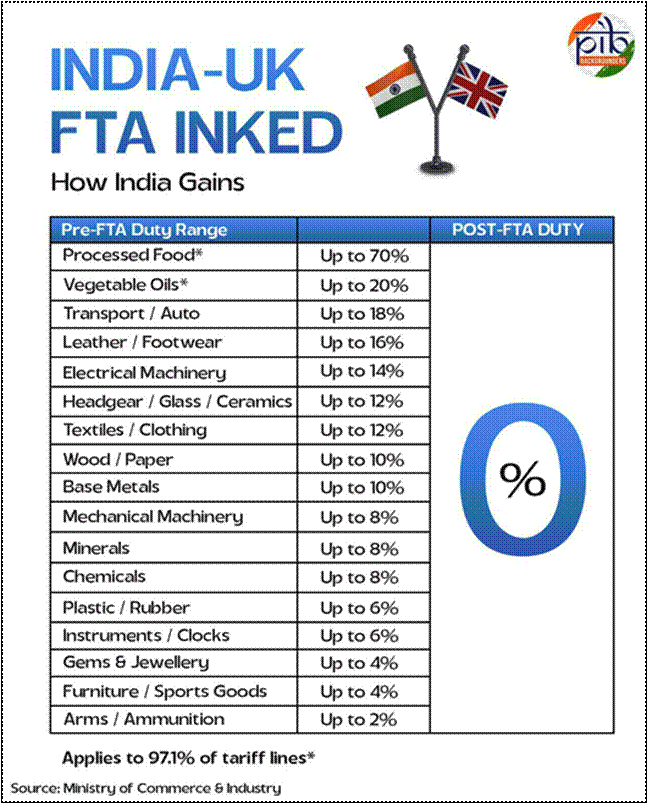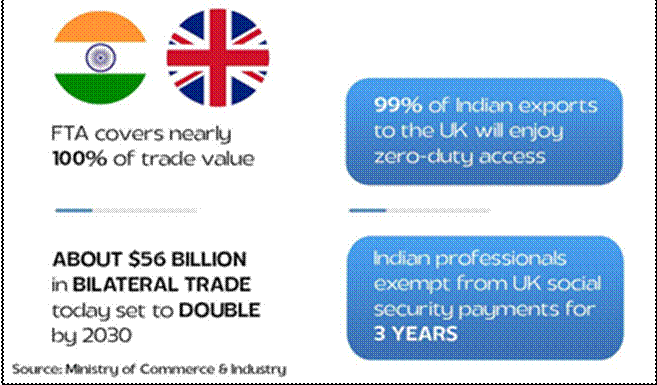Content:
- India–UK CETA
India–UK CETA
Overview
- Signed: July 24, 2025, by Commerce Minister Piyush Goyal and UK Secretary Jonathan Reynolds, with PMs Narendra Modi and Keir Starmer present.
- Bilateral Trade: USD 56 billion (USD 23 billion merchandise, USD 33 billion services), with a goal to double by 2030.
- Tariff Elimination: 99% of India’s exports to the UK duty-free, covering nearly 100% of trade value; India opens 89.5% of tariff lines for 91% of UK exports.
- Key Sectors: Textiles, leather, marine products, gems & jewellery, toys, engineering goods, chemicals, auto components, IT/ITES, financial services, healthcare, education.
- Impact: Job creation, export growth, and inclusive economic development for artisans, women-led enterprises, MSMEs, and farmers.
Relevance : GS 3(Economy ,Trade )

Key Features
- Tariff Elimination:
- India: Duty-free access for 99% of exports (textiles, leather, marine, gems, toys, chemicals, engineering, agri-products).
- UK: 89.5% of tariff lines opened, with 24.5% of exports getting immediate duty-free access. Sensitive sectors (dairy, cereals, pulses, gold, jewellery, smartphones, etc.) protected with phased liberalization (5-10 years for Make in India/PLI products).
- Safeguards: Bilateral measures to manage import surges.
- Simplified Rules of Origin:
- Self-certification for exporters, no origin documentation for consignments under £1,000, and Product Specific Rules (PSRs) aligned with India’s supply chains (textiles, machinery, pharma, processed food).
- Services and Professional Mobility:
- UK offers market access in 137 sub-sectors (IT, financial services, education, healthcare, telecom, etc.).
- Temporary entry for Indian professionals: Business Visitors (90 days), Intra-Corporate Transferees (3 years), Contractual Service Suppliers/Independent Professionals (12 months), no Economic Needs Test or numerical restrictions.
- Quota of 1,800 for Indian chefs, yoga instructors, and musicians annually.
- Double Contribution Convention (DCC):
- Exempts Indian workers/employers from UK social security contributions for 3 years, saving INR 4,000 crore (USD 500 million) for 75,000 workers and 900 companies.

Sector-Wise Gains
- Agriculture & Processed Food:
- Tariff Lines: Agriculture (1,437, 14.8%), Food Processing (985, 10.1%).
- Exports: India’s global agri-exports USD 45.05 billion (2022-23); UK imports USD 37.52 billion, India’s share USD 811 million.
- Growth: 50% rise in agri/processed food exports in 3 years; zero-duty access for tea, mangoes, grapes, spices, marine products.
- Competitive Edge: Matches EU, South Africa, Canada, etc., in fresh grapes, processed foods, bakery, preserved vegetables, sauces.
- States: Maharashtra, Gujarat, Kerala, Northeast benefit.
- Marine Products:
- Exports: USD 8.09 billion globally (2022-23), UK imports USD 5.4 billion, India’s share 2.25%.
- Growth: Tariff elimination (4.2-8.5%) boosts shrimp, tuna, fishmeal; exports to double capacity utilization.
- States: Kerala, Andhra Pradesh, Gujarat, Tamil Nadu, Odisha.
- Textiles & Clothing:
- Tariff Lines: 1,143 (11.7%), zero-duty from 12%.
- Exports: India’s global exports USD 36.71 billion, UK imports USD 26.95 billion, India’s share USD 1.79 billion.
- Growth: Eliminates duty disadvantage vs. Bangladesh, Pakistan; boosts RMG, home textiles, carpets, handicrafts.
- States: Tirupur, Surat, Ludhiana, Bhadohi, Moradabad.
- Leather & Footwear:
- Exports: USD 5 billion globally, USD 440 million to UK.
- Growth: Zero-duty access (from 16%) to UK’s USD 8.5 billion market; exports to hit USD 900 million, 5% market share gain.
- States: Uttar Pradesh, Tamil Nadu, West Bengal, Delhi NCR.
- Engineering Goods:
- Tariff Lines: 1,659 (17%).
- Exports: India’s global exports USD 77.79 billion, UK imports USD 193.52 billion, India’s share USD 4.28 billion.
- Growth: Exports to double to USD 7.5 billion by 2029-30; supports USD 300 billion target by 2030.
- Sectors: Electric machinery, auto parts, industrial equipment, aerospace, defense.
- States: Maharashtra, Gujarat, Tamil Nadu, Karnataka, Punjab.
- Electronics & Software:
- Exports: USD 35 billion globally, USD 2 billion to UK; UK imports USD 78 billion.
- Growth: Zero-duty access for TVs, monitors, telecom equipment; exports to double to USD 4 billion by 2030. Software/IT services to grow 15-20% annually.
- States: Tamil Nadu, Karnataka, Uttar Pradesh, Maharashtra, Gujarat.
- Pharmaceuticals & Medical Devices:
- Pharma: 56 tariff lines (0.6%), India’s global exports USD 23.31 billion, UK imports USD 30 billion, India’s share USD 1 billion.
- Medical Devices: Exports USD 2.2 billion globally, USD 37 million to UK; UK market USD 32 billion (2024), projected USD 69 billion by 2035.
- Growth: Zero-duty for generics, surgical instruments, diagnostics; mutual recognition of CDSCO/ICMED certifications.
- Competitive Edge: Outcompetes China, Brazil, Vietnam.
- Chemicals & Plastics:
- Chemicals: 1,206 tariff lines (12.4%), UK market USD 28.35 billion; exports to rise 30-40% (USD 650-750 million in 2025-26).
- Plastics: India’s exports USD 0.509 billion to UK, projected to reach USD 800 million in 3 years.
- Competitive Edge: Outcompetes US, China, Germany, France.
- Gems & Jewellery:
- Exports: USD 941 million to UK, projected to double in 2-3 years.
- Growth: Zero-duty from 4%; boosts jewellery (USD 400 million).
- States: Rajasthan, Delhi.
- Services:
- Trade Surplus: USD 6.6 billion (exports USD 19.8 billion, imports USD 13.2 billion).
- UK Commitments: 137 sub-sectors (IT, financial services, education, healthcare, telecom).
- India Commitments: 108 sub-sectors (accounting, telecom, environmental services).
- Growth: IT/ITES, fintech, education, healthcare; supports GCCs, startups.
Social & Economic Inclusion
- Farmers: Duty-free access to UK’s USD 63.4 billion agri-market; sensitive products (dairy, cereals, pulses, oils) protected.
- Fisherfolk: Boost to seafood exports, benefiting 28 million livelihoods.
- Workers: Job creation in labour-intensive sectors; labour rights protections.
- Women & Youth: Gender equality provisions, easier market access for startups, skill development.
- SMEs: 30.1% of GDP, 45.8% of exports; benefits from customs simplification, digital trade, SME contact point.
State-Wise Benefits
- Maharashtra: Engineering, pharma, apparel.
- Gujarat: Pharma, chemicals, engineering, marine.
- Tamil Nadu: Textiles, leather, engineering.
- Karnataka: Engineering, electronics, pharma.
- Andhra Pradesh: Marine, textiles.
- Odisha: Marine, handicrafts.
- Punjab: Textiles, engineering.
- West Bengal: Leather, tea, processed food.
- Kerala: Marine, spices.
- Rajasthan: Handicrafts, gems.
- Delhi: Apparel, engineering, jewellery.
Broader Impacts
- Supply Chains: Streamlined procedures, reduced compliance costs.
- Digital Trade: Paperless trade, electronic certification.
- Sustainability: Cooperation on clean tech, renewable energy.
- Skilling: Professional mobility, mutual recognition of qualifications.
- Inclusivity: Empowers women, youth, SMEs, and rural communities.
Conclusion
The India–UK CETA is a transformative agreement fostering trade, investment, and innovation while prioritizing inclusivity and sustainability. It strengthens economic resilience, enhances global value chain integration, and paves the way for inclusive growth across India’s diverse sectors and regions.



